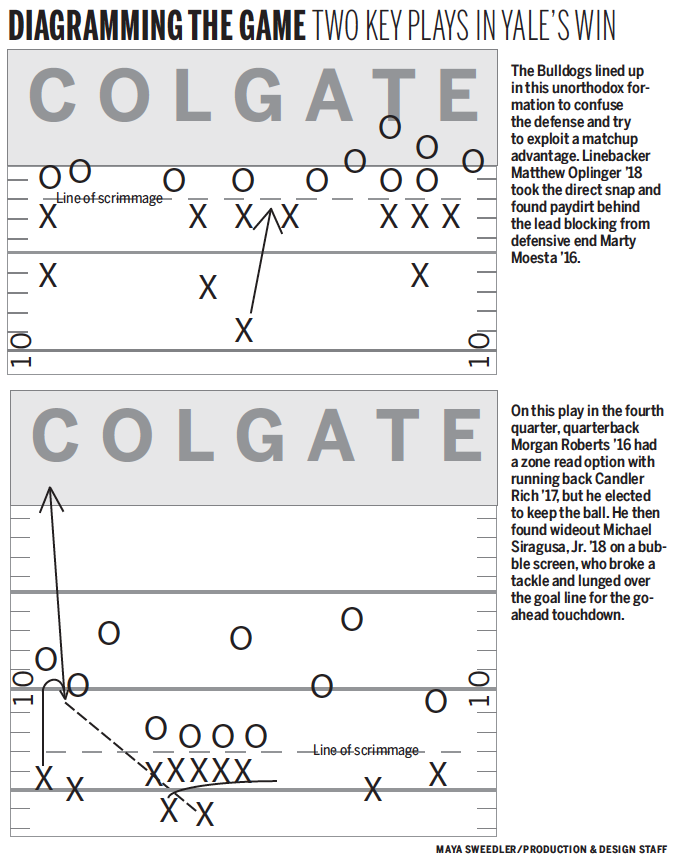Though the Yale football team did not look completely polished in its 29–28 win over Colgate on Saturday, the Bulldogs executed just enough plays, both offensively and defensively, to erase a 14-point deficit and secure a 1–0 start to the season. Two of those plays, a two-point conversion by linebacker Matt Oplinger ’18 and the game-winning touchdown reception by wide receiver Michael Siragusa After a touchdown reception by wideout Robert Clemons III ’17 with 7:19 remaining in the fourth quarter, the Bulldogs were down 28–20. A successful extra point from kicker Bryan Holmes ’17 would have ensured that another touchdown would tie the score. That was certainly an option that Yale was considering at the time, but the swinging gate formation, which head coach Tony Reno has made a consistent part of Yale’s special teams strategy, allowed for a better play.
The swinging gate formation, often used in extra point situations, involves an unconventional positioning strategy in which many blockers on the field goal unit initially line up off to the side, isolating just two or three players behind the long snapper. The eligible receivers near the sideline force the defense to cover that part of the field heavily, to avoid an easy passing conversion, while it must also defend against a direct snap rush from those behind the ball. With proper planning, the defense can align its players appropriately in order to protect against both threats. In such cases, the offense has its kicker and holder on the field and can switch to a proper field goal formation, as Yale has done numerous times under Reno.
The Raiders managed to position themselves correctly when the Elis used the formation once in the first half, but after Clemons’ fourth quarter touchdown, Yale saw something different. With Oplinger and defensive end Marty Moesta ’17 lined up in the backfield behind three blockers, Colgate had just three players at the line. Left guard Mason Friedline ’17 snapped the ball directly to Oplinger, who dashed easily into the end zone for two points. The three-man offensive line provided well-executed blocking to guarantee the score, while the other six players for Yale and eight for Colgate were eliminated completely from the play.
The conversion brought the score to 28–22 and proved to be a major difference-mThat final touchdown came shortly after a stop by Yale’s defense on a 13-yard reception by Siragusa. The sophomore, now serving as a starting wide receiver, led receivers with seven receptions for 82 yards after catching that many passes throughout the entire 2014 season. Siragusa was effective at gaining ground after his catches throughout the game, and that ability was a key to the game-winning score late in the fourth quarter.
 Siragusa’s catch was the result of a three-pronged option play in which a shotgun run, quarterback bootleg and screen pass were all threats to the defense. With running back Candler Rich ’17 lined up to his left, Roberts took the snap and immediately began reading the left side of the defensive line.
Siragusa’s catch was the result of a three-pronged option play in which a shotgun run, quarterback bootleg and screen pass were all threats to the defense. With running back Candler Rich ’17 lined up to his left, Roberts took the snap and immediately began reading the left side of the defensive line.
Roberts elected to fake the handoff to Rich, who cut to the right of the line, leaving himself with the option of taking the ball himself around the left tackle or passing. Roberts moved forward just enough to keep Colgate’s left end on his toes, leaving Siragusa open for a quick screen pass to the left. Siragusa had two defenders to avoid on his side of the field, one of whom was blocked successfully by tight end Stephen Buric ’16. Colgate defensive back Chris Morgan attempted to tackle Siragusa down low, but this was not enough to get more than Siragusa’s hand on the ground. Siragusa continued advancing toward the end zone and eventually bowled over safety Keyon Washington into the end zone.
Following an extra point from Holmes, Yale needed just one defensive stop to seal the victory. The defense took care of its role in the final minutes, allowing the Bulldogs to walk away with a win in their first game of the season.







